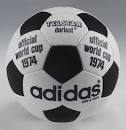A nice story of monopoly. Adidas has held the monopoly right over production of the FIFA World Cup ball since 1970. As is often the case today, I get requests for the latest sporting equipment on sale. The 2022 Qatar World Cup football retails at €28. I have never paid €28 for a football in my life but the economics of the situation make this price point possible.
Since the 1970 World Cup in Adidas has been the official and sole supplier of the World Cup ball. The Germany company began production of footballs in 1963 and did not supply England's 1966 tournament. Instead the official ball - the Challenge 4-Star - was made by British sporting goods company Slazenger. The 1966 ball was made with 18 rectangular panels and was orange in colour. Marking and branding was difficult to see in action.
Adidas would change this forever in 1970. The Telstar was the first 32-panel black-and-white ball used. Only 20 balls were supplied by Adidas for the competition. A brown ball was used during the Germany versus Peru game, while a white ball was used during the first half of Italy versus Germany.
 Telstar Durlast - Germany 1974
Telstar Durlast - Germany 1974 As the years progressed, adidas innovated with the design and composition of the ball. In 1999 the Germany maufacturer produced their first ball for the Women's World Cup - the Icon - and followed this up in 2011, 2015 and 2019.
The 2018 installment - the Telstar 18 - even included a colour change for the knockout rounds.
And while countries, hosts and players have all changed through the years, adidas's monopoly on supply has remained constant. In the end I will probably be pressured into spending €28. I can rationalize it by telling myself the tournament only comes once every 4 years.
 RSS Feed
RSS Feed